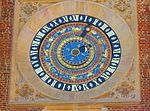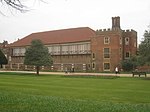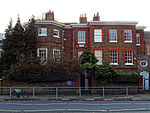Hampton Court Palace

Hampton Court Palace is a Grade I listed royal palace in the London Borough of Richmond upon Thames, 12 miles (19 kilometres) southwest and upstream of central London on the River Thames. The building of the palace began in 1514 for Cardinal Thomas Wolsey, the chief minister of Henry VIII. In 1529, as Wolsey fell from favour, the cardinal gave the palace to the king to check his disgrace. The palace went on to become one of Henry's most favoured residences; soon after acquiring the property, he arranged for it to be enlarged so that it might more easily accommodate his sizeable retinue of courtiers. The palace is currently in the possession of King Charles III and the Crown. In the following century, King William III's massive rebuilding and expansion work, which was intended to rival the Palace of Versailles, destroyed much of the Tudor palace. His work ceased in 1694, leaving the palace in two distinct contrasting architectural styles, domestic Tudor and Baroque. While the palace's styles are an accident of fate, a unity exists due to the use of pink bricks and a symmetrical, if vague, balancing of successive low wings. King George II was the last monarch to reside in the palace. Today, the palace is open to the public and a major tourist attraction, easily reached by train from Waterloo station in central London and served by Hampton Court railway station in East Molesey, in Transport for London's Zone 6. In addition, London Buses routes 111, 216, 411 and R68 stop outside the palace gates. The structure and grounds are cared for by an independent charity, Historic Royal Palaces, which receives no funding from the Government or the Crown. In addition, the palace displays many works of art from the Royal Collection. Apart from the palace itself and its gardens, other points of interest for visitors include the celebrated maze, the historic royal tennis court (see below), and the huge grape vine, the largest in the world as of 2005. The palace's Home Park is the site of the annual Hampton Court Palace Festival and Hampton Court Garden Festival.
Excerpt from the Wikipedia article Hampton Court Palace (License: CC BY-SA 3.0, Authors, Images).Hampton Court Palace
Barge Walk, London
Geographical coordinates (GPS) Address External links Nearby Places Show on map
Geographical coordinates (GPS)
| Latitude | Longitude |
|---|---|
| N 51.403333333333 ° | E -0.3375 ° |
Address
Hampton Court Palace
Barge Walk
KT8 9BN London (London Borough of Richmond upon Thames)
England, United Kingdom
Open on Google Maps










